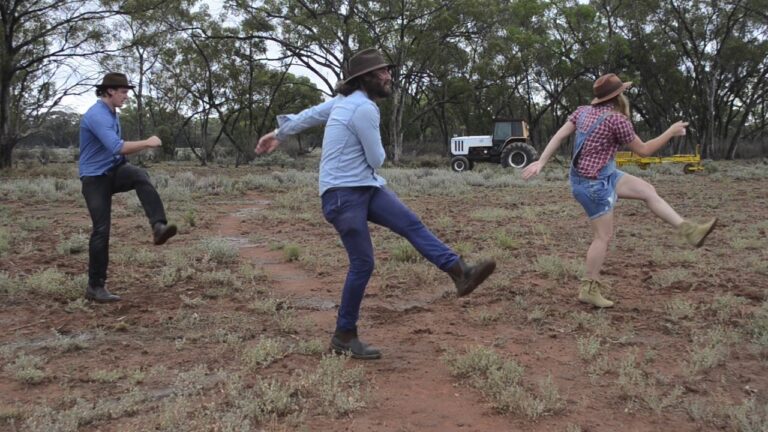From the Macarena to the YMCA, we just can’t seem to get enough of ridiculous dances.
Lately, we can’t help but be brought back to our primary school days when – in some strange Aussie rite of passage – every student would suddenly crank out the Nutbush City Limits en masse at the end of year school disco.
But it’s not just the moves of the Nutbush that people around the world are familiar with — there are countless universal dance routines that every man and his dog seem to know. Plus, there’s always some sort of iconic dance fad that defines an era – the Jitterbug of the 1930s, the Lindy Hop of the ’40s, the Twist of the ’60s.
Whether the dances be the result of a fleeting moment in pop culture, like the ‘Macarena’, or a fad of a more ambiguous origin (where the hell did the Chicken Dance come from?), dances crazes are, and continue to be, ingrained in society, but why do we love them so much?
Dance is historically a huge part of many cultures worldwide, and dance brings people together.
Combine that with the growing presence of social media, and viral dance fads are spread from country to country faster than ever.
Just look at Drake’s ‘In My Feelings’ challenge, ‘Flossing’, and the ‘Whip/Nae Nae’ — all routines or “challenges” that have been born out of their popularity among youth culture and a way of remaining on trend with the latest happenings in pop culture.
Join us as we take a look at some of the favourite fad dances across the years.
The Chicken Dance
The Chicken Dance is particularly well-known since basically anyone can do it and the entire point is to look silly. What’s less known, however, is its origin.
It was actually written in the late 1950s by a Swiss accordion player named Werner Thomas, who at the time tended a flock of ducks and geese — so the tune was actually originally called ‘Der Ententanz’ (The Duck Dance).
After performing the song in 1963, Thomas performed the song in a restaurant and people spontaneously “began to move with the melody” — which eventually evolved to include a beak, wing and tail motions.
Then, in 1971 a Belgian music publisher stopped in the restaurant and took a liking to the song, adding Dutch lyrics and releasing it across Europe, where it quickly became a hit. It soon became prevalent at Oktoberfest, and by the ’90s it was a staple among karaoke CDs, dance compilations and TV commercials.
The Hokey Pokey
Fun fact: the ‘Hokey Pokey’ is known by a whole bunch of different names across the world. In the UK it’s the ‘Hokey Cokey’ (wut?), in Denmark it’s known as ‘the Boogie Woogie’, and in New Zealand, it’s the ‘Hokey Tokey’.
Apparently, it all began in 1942 when Irish songwriter Jimmy Kennedy, best known for “The Teddy Bear’s Picnic,” created a dance and song to go along with it, calling it ‘The Hokey Cokey.’ It was created to entertain Canadian troops stationed in London.
One year later, Al Tabor, who was also entertaining Canadian troops, basically ripped off the whole thing and called it ‘The Hokey Pokey’ — saying that the name came from the London ice cream vendors of his childhood.
Tabor and Kennedy later went to court and settled, with all rights going to the original creator. The dance and lyrics gradually mutated over the decades, to what we know now in Australia as ‘The Hokey Pokey.’
YMCA
Who could forget the Village People’s hugely popular jig to their 1978 hit ‘YMCA’?! The dance for the iconic party tune actually began on a television show, Dick Clark’s American Bandstand, in 1979. The episode featured the Village People as guests, and the now infamous (and very easy to learn) dance was performed by audience members while the group performed the hit.
When the host noticed the audience spelling out the letters with their arms, he asked founding band member Victor Willis, “Do you think you can work this dance into your routine?” Willis responded, “I think we’re gonna have to.”
The rest, as they say, is history.
The Nutbush
In what seems to be a uniquely Australian phenomenon, the ‘Nutbush’ dance – inspired by the Tina Turner song (which is actually about her hometown of Tennessee) – first emerged in the 1970s disco era.
It took off in Australia during the 1980s and is often performed in schools, social gatherings and community events. It’s so popular that it’s literally a part of the curriculum in some primary schools. Only in ‘Straya!
The Macarena
Eyyyyy Macarena! You’d be hard-pressed to find someone who grew up in the ’90s and wasn’t familiar with this Spanish tune.
Originally by Los Del Rio, the 1996 reworked version of the track featured English lyrics and a clubby beat, and before long, ‘Macarena (Bayside Boys remix)’ was smashing the charts across the globe and remained No. 1 on the U.S. Billboard Hot 100 singles chart for 14 weeks.
The subsequent film clip to the remix featured women doing the now-famous Macarena dance around the world and was soon in the mainstream as the song soared in popularity globally.
Director Vincent Calvet told Huffington Post: “I thought the music video could provide somewhat of a dance lesson”.
It definitely did!
Gangnam Style
In 2012, you absolutely could not escape the annoyingly catchy K-Pop tune that was Psy’s ‘Gangnam Style’. It. Was. Literally. EVERYWHERE, and it was also the first video to ever hit two billion views on YouTube.
The insanely viral appeal of the music vid has been attributed to its accompanying dance move — ‘the horse-riding dance’ — which combines the elements of shuffle dancing and hand movements that resemble a horseback rider.
It held the YouTube record for the most-watched video for an impressive five years, before Wiz Khalifa’s ‘See You Again’ took the crown.


































